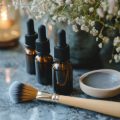Understanding Fragrance-Free vs. Unscented Products
When it comes to choosing personal care and household products in the United States, consumers often encounter labels like “fragrance-free” and “unscented.” While these terms sound similar, they have distinct meanings that can significantly impact your health and product experience. Fragrance-free means a product contains no added fragrance chemicals or masking scents, making it ideal for individuals with sensitivities or allergies to synthetic fragrances. On the other hand, unscented products may not have an obvious smell but can still include chemicals specifically designed to mask odors or neutralize natural scents. This distinction matters because U.S. regulations do not require companies to fully disclose all fragrance ingredients—many of which are synthetic and potentially irritating. For people with sensitive skin, asthma, or fragrance allergies, understanding these labels is crucial for making informed, safer choices. Always check ingredient lists and remember: “unscented” does not always mean free from fragrance-related compounds.
2. What Are Synthetic Scents?
Synthetic scents, also known as artificial or man-made fragrances, are chemically engineered compounds designed to mimic or enhance natural aromas. Unlike essential oils or botanical extracts, which are derived directly from plants, synthetic fragrances are created in labs using a combination of chemical ingredients. These scents are widely used in American personal care products—like shampoos, lotions, deodorants—and household items such as detergents, air fresheners, and candles.
Common Types of Synthetic Fragrances
There are several categories of synthetic scent compounds commonly found in consumer products. Here’s a quick breakdown:
| Type of Compound | Main Usage | Common Products |
|---|---|---|
| Phthalates | Used to make scents last longer | Perfumes, body sprays, air fresheners |
| Musk Ketones | Adds a musky aroma | Laundry detergents, soaps, colognes |
| Aldehydes | Imparts fresh or citrus notes | Cleaning products, shampoos, lotions |
| Synthetic Esters | Creates fruity or floral scents | Candles, hair care products, creams |
How Synthetic Scents Are Formulated
The formulation of synthetic fragrances typically involves blending multiple aromatic chemicals with solvents and stabilizers. This process allows manufacturers to create consistent scent profiles at a large scale and lower cost compared to natural alternatives. The final formula is often considered proprietary and listed simply as “fragrance” or “parfum” on ingredient labels in the U.S., making it difficult for consumers to know exactly what chemicals are included.
Why Use Synthetic Scents?
- Cost-effectiveness: Cheaper than extracting natural oils.
- Consistency: Delivers uniform scent batches every time.
- Longevity: Many synthetics are designed to linger longer on skin or surfaces.
Key Takeaway:
Synthetic fragrances are complex mixtures crafted for performance and affordability. However, their widespread use means consumers should be aware of what they’re exposed to—especially if fragrance-free safety is a concern.

3. Potential Risks of Synthetic Fragrance Ingredients
Synthetic fragrances are commonly used in a wide range of personal care and household products, but they come with several safety concerns that consumers should be aware of. These risks can affect not only individuals with sensitivities but also the broader population through daily exposure.
Allergens: Hidden Irritants
One of the primary issues with synthetic scents is their potential to trigger allergic reactions. Many fragrance compounds are known allergens and can cause skin irritation, rashes, headaches, or even more severe reactions in sensitive individuals. Since U.S. regulations often allow companies to list “fragrance” as a single ingredient without disclosing specific chemicals, it can be challenging for consumers to identify and avoid problematic substances.
Endocrine Disruptors: A Subtle Threat
Certain synthetic fragrance ingredients, such as phthalates and some musks, have been identified as potential endocrine disruptors. These chemicals may interfere with hormone function, which has been linked to reproductive issues, developmental problems in children, and other long-term health concerns. The lack of full transparency in ingredient lists makes it difficult for consumers to make informed choices about the products they bring into their homes.
Respiratory Issues: Air Quality Concerns
Exposure to synthetic fragrances—especially in poorly ventilated spaces—can aggravate respiratory conditions like asthma and allergies. Some volatile organic compounds (VOCs) released by fragranced products contribute to indoor air pollution and may trigger coughing, sneezing, or shortness of breath even in people without preexisting conditions.
Why This Matters for Everyday Consumers
The cumulative effect of these risks highlights the importance of understanding what’s really inside the products you use daily. For Americans seeking safer alternatives, fragrance-free products—or those made with transparent, natural scent sources—may offer peace of mind and support better long-term health outcomes.
4. Do Fragrance-Free Products Mean Safer Choices?
Many consumers assume that “fragrance-free” automatically equals “safer,” but the reality is more nuanced. Removing synthetic fragrances can reduce exposure to certain allergens or irritants, especially for those with sensitive skin or fragrance allergies. However, the absence of synthetic scents does not guarantee a product is free from other potentially harmful ingredients.
Fragrance-Free vs. Unscented: Key Differences
| Label | Description | Potential Concerns |
|---|---|---|
| Fragrance-Free | No added fragrance ingredients (synthetic or natural) | May still contain other irritants or sensitizers |
| Unscented | No noticeable scent, but may use masking agents to cover odors | Masking agents can cause irritation in sensitive individuals |
Other Ingredients to Watch For
- Preservatives: Chemicals like parabens and formaldehyde releasers are common in personal care products and may cause skin reactions.
- Sulfates: Often used as cleansing agents; can strip moisture and irritate sensitive skin.
- Dyes and Colorants: Synthetic colors may trigger allergies or sensitivities.
- Alcohols: Certain types (like denatured alcohol) can be drying or irritating, especially in high concentrations.
- Botanical Extracts: “Natural” doesn’t always mean safe—plant extracts can also be potent allergens.
The Bottom Line: Holistic Ingredient Analysis Matters
Avoiding synthetic fragrances is a smart step for those with sensitivities, but it shouldn’t be your only focus when evaluating product safety. Always read the full ingredient list and look out for other common irritants or allergens. Patch testing new products on a small area of skin before regular use is a practical way to minimize risk, regardless of fragrance claims.
5. Regulatory Standards and Labeling in the US
When it comes to fragrance ingredients in personal care and household products, understanding how these substances are regulated is essential for making informed choices—especially if you’re considering fragrance-free alternatives for safety reasons. In the United States, regulatory oversight of fragrances falls primarily under the jurisdiction of the Food and Drug Administration (FDA) and, for consumer products outside of cosmetics, the Consumer Product Safety Commission (CPSC).
How Are Fragrance Ingredients Regulated?
The FDA regulates cosmetic products, which includes skincare, makeup, shampoos, and deodorants. However, when it comes to fragrances specifically, there’s a notable lack of stringent oversight. The FDA does not require pre-market approval for cosmetic ingredients (with the exception of color additives), meaning manufacturers can include a wide array of synthetic or natural fragrance chemicals without specific FDA evaluation for safety before products hit the shelves.
Ingredient Disclosure Requirements
On product labels, manufacturers are allowed to list “fragrance” or “parfum” as a single ingredient—even if that term covers dozens or even hundreds of individual chemical compounds. This practice is protected under trade secret laws designed to prevent competitors from copying proprietary scent formulas. While this protects business interests, it means consumers rarely know exactly what chemicals they are being exposed to—potentially problematic for those with allergies, sensitivities, or health concerns.
What About Other Agencies?
The CPSC oversees labeling for household cleaning products and air fresheners. Similar to cosmetics, full disclosure of all fragrance ingredients isn’t required; only certain hazardous chemicals must be listed if present above specific concentrations. The Environmental Protection Agency (EPA) may also regulate some components used in air care products or disinfectants but does not require comprehensive fragrance transparency either.
Gaps in Current Policy
This patchwork approach leaves significant gaps in consumer protection:
- Lack of Transparency: Consumers cannot easily identify potentially harmful or irritating ingredients because of the generic “fragrance” label.
- No Pre-Market Safety Testing: Most fragrance chemicals are not independently tested by regulatory agencies before use.
- Limited Allergen Disclosure: Unlike regulations in the European Union—which require disclosure of 26 known allergens—U.S. rules do not mandate such specificity on labels.
If you’re concerned about synthetic scents or have fragrance sensitivities, understanding these regulatory limitations can guide you toward safer choices—like genuinely fragrance-free products that typically avoid both natural and synthetic aromatic compounds altogether. Always look for brands that voluntarily provide full ingredient transparency or third-party certifications to ensure you’re getting what you expect.
6. How to Shop Smarter for Sensitive or Allergy-Prone Skin
When it comes to protecting yourself and your family from unwanted reactions to synthetic scents, shopping smart is key. Here’s how to take a more technical, informed approach at the store or online as an American consumer.
Decode Labels Like a Pro
First, don’t just look for “fragrance-free” on the front of the package. Check the ingredient list for terms like “parfum,” “fragrance,” “aroma,” or even “essential oils.” In the US, brands aren’t required to list every fragrance chemical, so be wary of vague language. Products labeled “unscented” can still contain masking fragrances. Opt for those explicitly marked “fragrance-free” and double-check the fine print.
Vet Brands for Transparency
Do your homework on brands before you buy. Look for companies that practice full ingredient disclosure and have a track record of catering to sensitive skin or allergy-prone customers. Trustworthy brands will answer questions about their fragrance policy or provide detailed safety data upon request. Certifications like the National Eczema Association Seal or third-party allergy testing are good signals of reliability.
Use Trusted Resources
Utilize databases such as the Environmental Working Group (EWG) Skin Deep database or the MADE SAFE certification site to cross-reference products and ingredients. These platforms can help you filter out products with problematic synthetic scents or potential allergens based on scientific review.
Patch Test Every New Product
No matter how careful you are, always patch test new skincare, haircare, or household items on a small area of skin before full use. This practical step can help prevent larger allergic reactions for you or your family members.
Stay Up-to-Date with Regulations
Regulations regarding fragrance disclosure in the US may change over time. Follow updates from the FDA and advocacy groups so you’re aware of new labeling requirements or product recalls.
Empower Your Family
Educate household members—especially children—on why you’re making these choices. Awareness helps everyone stay vigilant about checking labels and reporting any adverse reactions early.
The bottom line: Shopping smarter means combining label literacy, brand research, technical resources, and proactive habits. By following these steps, you’ll reduce your risk of unwanted exposure to synthetic scents while supporting safer choices for sensitive or allergy-prone skin in your American household.


